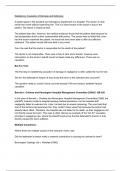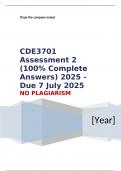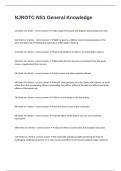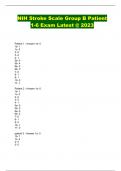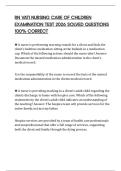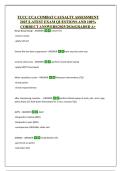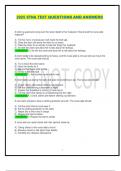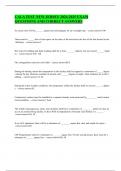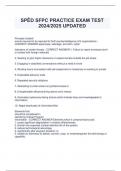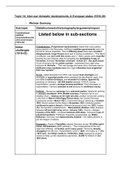Negligence: Causation of Damage and Defences:
A patient goes to the accident and emergency department at a hospital. The doctor on duty
sends him home without examining him. This is a clear breach of the doctor’s duty to the
patient. The doctor is clearly at fault.
The patient later dies. However, the medical evidence shows that the patient died because he
had accidentally drunk a drink contaminated with poison. The poison was so lethal that, even
had the doctor examined the patient, he would not have been able to offer any effective
treatment. The patient would still have died in any event.
Can it be said that the doctor is responsible for the death of the patient?
The doctor is not responsible. There was a duty of care and a breach, however even
intervention on the doctor’s behalf would not hade made any difference. There was no
causation.
But For Test:
The first step in establishing causation of damage in negligence is often called the ‘but for test’.
‘But for’ the defendant’s breach of duty would the harm to the claimant have occurred?
The question really is, would it have occurred anyway? We are trying to establish factual
causation
Barnett v. Chelsea and Kensington Hospital Management Committee [1969] 1 QB 428
In the case of Barnett v. Chelsea and Kensington Hospital Management Committee [1969], the
plaintiff's husband visited a hospital seeking medical assistance, but the hospital staff
negligently failed to examine him. Later, he died due to arsenic poisoning. The court held that
even if the doctors had examined him, they couldn't have saved him because the poison had
already taken effect. Therefore, the hospital was not liable for his death, as their negligence did
not directly cause the harm. This case is often cited as an example of the "but for" causation
principle in negligence law, where the plaintiff must prove that the defendant's breach of duty
directly caused the harm suffered.
Multiple Causations:
Where there are multiple causes of the claimant’s harm, ask:
Did the defendant’s breach make a material contribution to causing the claimant’s harm?
Bonnington Castings Ltd v. Wardlaw [1956]
, In Bonnington Castings Ltd v. Wardlaw (1956), the court ruled that if a plaintiff can prove that
the defendant's negligence materially contributed to the harm, even if it was not the sole cause,
the defendant can still be held liable. This established the principle of "material contribution to
risk" in English tort law, which broadened the scope of liability for negligence cases.
In this case it is easier for the claimant to satisfy. Why? In the but for test, you have to show that
it’s more than 50% likely you would not have suffered the harm anyway. By contrast, this
approach simply requires that the defendants breach materially contributed to the harm that was
suffered. It does not need to be more than 50%. The courts have never defined material. It is
somewhere between 0-50%
The judge decides which test is more appropriate. The test will only use MC test when there is
more than 1 cause. If there is 1 cause the judge will use the but for test.
In a case where there were more than one causers to the harm, we need to ask whether
this harm is divisible or indivisible.
There are 2 types of damage.
1. Divisible - Increased dose of harmful agent worsened damage
a. E.g. Asbestos
2. Indivisible - Increased dose of harmful agent didn’t worse damage
a. Cancer
Indivisible
Passenger in taxi, taxi driver is above the speed limit so he is in breach of duty of care. He
collides with van being driven by driver who was also above speed limit so he was also in
breach of care to all other road users and passengers. Both were in breach. The injured party
here is the passenger. This is in indivisible injury. Most are. Who pays damages?
Where the claimant suffers one indivisible injury:
- All tortfeasors who caused that harm are liable to the claimant in full
You can’t sue both and expect double compensation.
- As between themselves, tortfeasors are liable to contribute according to the extent of
their responsibility for the damage. Civil Liability (Contribution) Act 1978
Divisible
A patient goes to the accident and emergency department at a hospital. The doctor on duty
sends him home without examining him. This is a clear breach of the doctor’s duty to the
patient. The doctor is clearly at fault.
The patient later dies. However, the medical evidence shows that the patient died because he
had accidentally drunk a drink contaminated with poison. The poison was so lethal that, even
had the doctor examined the patient, he would not have been able to offer any effective
treatment. The patient would still have died in any event.
Can it be said that the doctor is responsible for the death of the patient?
The doctor is not responsible. There was a duty of care and a breach, however even
intervention on the doctor’s behalf would not hade made any difference. There was no
causation.
But For Test:
The first step in establishing causation of damage in negligence is often called the ‘but for test’.
‘But for’ the defendant’s breach of duty would the harm to the claimant have occurred?
The question really is, would it have occurred anyway? We are trying to establish factual
causation
Barnett v. Chelsea and Kensington Hospital Management Committee [1969] 1 QB 428
In the case of Barnett v. Chelsea and Kensington Hospital Management Committee [1969], the
plaintiff's husband visited a hospital seeking medical assistance, but the hospital staff
negligently failed to examine him. Later, he died due to arsenic poisoning. The court held that
even if the doctors had examined him, they couldn't have saved him because the poison had
already taken effect. Therefore, the hospital was not liable for his death, as their negligence did
not directly cause the harm. This case is often cited as an example of the "but for" causation
principle in negligence law, where the plaintiff must prove that the defendant's breach of duty
directly caused the harm suffered.
Multiple Causations:
Where there are multiple causes of the claimant’s harm, ask:
Did the defendant’s breach make a material contribution to causing the claimant’s harm?
Bonnington Castings Ltd v. Wardlaw [1956]
, In Bonnington Castings Ltd v. Wardlaw (1956), the court ruled that if a plaintiff can prove that
the defendant's negligence materially contributed to the harm, even if it was not the sole cause,
the defendant can still be held liable. This established the principle of "material contribution to
risk" in English tort law, which broadened the scope of liability for negligence cases.
In this case it is easier for the claimant to satisfy. Why? In the but for test, you have to show that
it’s more than 50% likely you would not have suffered the harm anyway. By contrast, this
approach simply requires that the defendants breach materially contributed to the harm that was
suffered. It does not need to be more than 50%. The courts have never defined material. It is
somewhere between 0-50%
The judge decides which test is more appropriate. The test will only use MC test when there is
more than 1 cause. If there is 1 cause the judge will use the but for test.
In a case where there were more than one causers to the harm, we need to ask whether
this harm is divisible or indivisible.
There are 2 types of damage.
1. Divisible - Increased dose of harmful agent worsened damage
a. E.g. Asbestos
2. Indivisible - Increased dose of harmful agent didn’t worse damage
a. Cancer
Indivisible
Passenger in taxi, taxi driver is above the speed limit so he is in breach of duty of care. He
collides with van being driven by driver who was also above speed limit so he was also in
breach of care to all other road users and passengers. Both were in breach. The injured party
here is the passenger. This is in indivisible injury. Most are. Who pays damages?
Where the claimant suffers one indivisible injury:
- All tortfeasors who caused that harm are liable to the claimant in full
You can’t sue both and expect double compensation.
- As between themselves, tortfeasors are liable to contribute according to the extent of
their responsibility for the damage. Civil Liability (Contribution) Act 1978
Divisible

